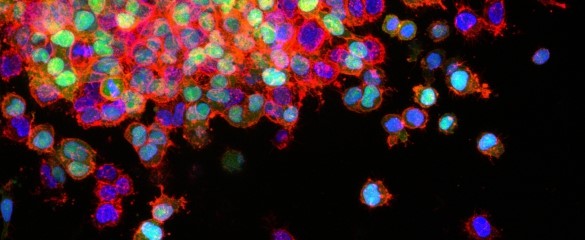Nanomaterials have the potential for cancer diagnosis and therapy simultaneously. Separate investigations by researchers in France and in the United States suggest the results could be particularly effective for aggressive forms of cancer.
At the National Institute of Applied Sciences of Lyon (INSA Lyon), France, Vladimir Lysenko’s team is investigating four types of carbon nanomaterials to understand which has the most promise to be used as a theranostic tool, as
reported in Horizon, a publication of the European Commission.
The team's primary goal is to deliver light-and sound-sensitive nanomaterials to cancer cells in patients. The nanoparticles then would be activated by a light source, or through ultrasound, or both.
TWO TYPES OF ACTIVATION, TWO PURPOSES
Gentle activation would allow the cells attached, or labeled, with the nanomaterials to be imaged for easier diagnosis, whereas strong activation would destroy the cancer cells hosting the nanoparticles.
Nanomaterials could reach cancer cells one of two ways after introduction into the human body. The first approach would tweak the nanoparticles so they specifically recognize cancer cells.
The other method, according to Horizon, "is to harness the fact that cancer cells grow in a fast and uncontrolled way, and would therefore naturally pick up a higher concentration of these materials than healthy cells." This approach would mean that fast-growing, aggressive cancers would be particularly susceptible.
Lysenko’s team currently is investigating four different types of nanoparticles to determine which would work best: carbon fluroxide nanoparticles, nanodiamonds, carbon nanotubes and graphene.
"They are all based on carbon, which means that the only difference is the form and the surface chemical binding of the carbon (atoms)," Lysenko says. "We will see how the sizes and the shapes of the nanomaterials will impact, for example, their biocompatibility."
'CORNELL DOTS' SHOW POTENTIAL IN CANCER ERADICATION
Nanoparticles known as Cornell dots, or C dots, have shown great promise as a therapeutic tool in the detection and treatment of cancer.
The ultrasmall particles, developed more than a dozen years ago by Ulrich Wiesner, an engineering professor at Cornell University, have demonstrated they can kill cancer cells without having to carry drugs.
“If you had to design a nanoparticle for killing cancer, this would be exactly the way you would do it,” says Wiesner, lead investigator of the study. “The particle is well tolerated in normally healthy tissue, but as soon as you have a tumor, and under very specific conditions, these particles become killers.”
C dots, administered in large doses and with the tumors in a state of nutrient deprivation, trigger a type of cell death called ferroptosis.
Wiesner’s fluorescent silica particles, as small as 5 nanometers in diameter, were originally designed to be used as diagnostic tools, attaching to cancer cells and lighting up to show a surgeon where the tumor cells are, much like with Lysenko's investigation.
When incubated with cancer cells at high doses with cancer cells in a state of nutrient deprivation, Wiesner’s peptide-coated C dots show the ability to adsorb iron from the environment and deliver this into cancer cells.
This process triggers ferroptosis, a necrotic form of cell death involving plasma membrane rupture, which differs from the typical cell fragmentation found during a more commonly observed form of cell death called apoptosis.
Wiesner's team of researchers discovered that in 24 to 48 hours after the cancer cells were exposed to the dots, there was a “wave of destruction” throughout the entire cell culture.
Tumors also shrank when mice were administered multiple high dose injections without any adverse reactions.
Future work will focus on using nanoparticles in combination with other standard therapies for a given tumor type. Researchers will also look to tailor the particle to target specific cancers.




